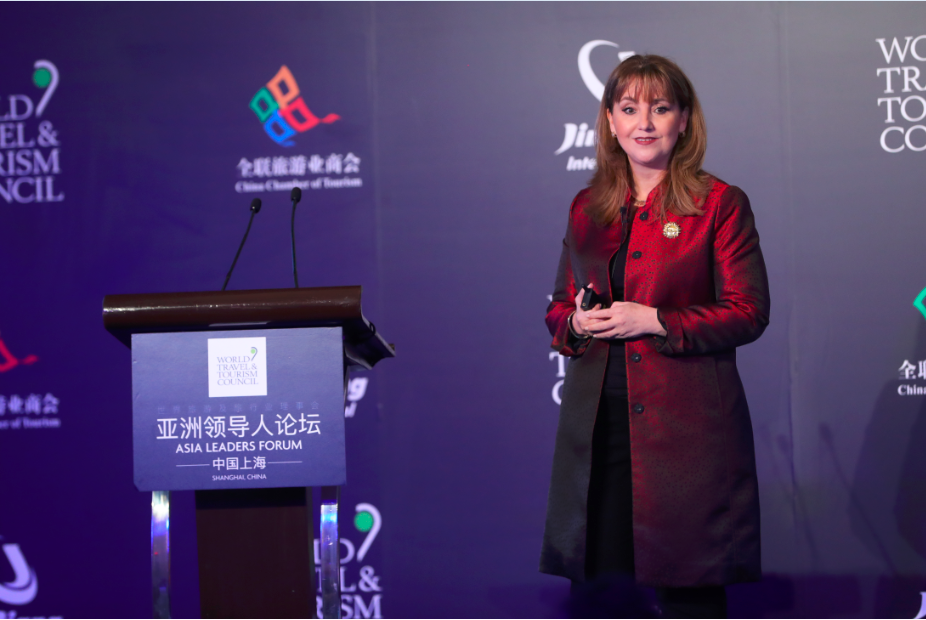提示:全球旅游产业的增长率连续五年超过总体经济的增长率。一旦新冠病毒大流行得以控制,旅游业将为亚太地区的经济复苏做出重要贡献。

世界旅游及旅行业理事会(WTTC)最新发布了《经济影响力报告》(Economic Impact Report,以下简称“EIR”)。WTTC有30年历史,是代表全球旅游及旅行业非公共部门的机构。WTTC对世界185个国家和地区的旅游经济已经进行了超过25年的跟踪研究,2020年4月发布的年度报告是对2019年世界旅游经济的阐述。
EIR显示,2019年旅游业在推动亚太地区经济发展方面起了重要作用,促进因素包括中等收入家庭的持续增长、签证便利化、互联互通改善以及政府对旅游业的重视。2019年亚太地区旅游产业创造的GDP为2.971万亿美元。占地区经济总量的9.8%,比上一年度增长5.5%,连续第五年超过地区总体经济增幅(后者的增幅为4.2%)。此外,国际游客消费总额达到5,480亿美元,占亚太地区出口总额的6.6%。过去五年的数据表明,亚太地区旅游业在提供就业方面居世界第一,新提供了2100多万份工作,相当于全球新增就业岗位的56%。本综合报告还显示,休闲旅游占旅游消费总额的81%、商务旅行占19%。国内旅游与国际旅游消费的数字也呈现了类似的偏差:国内游客消费占总消费的74%,而国际消费占26%。
2019年中国在GDP和就业规模方面居亚太地区之首,超过亚洲其他主要市场,比如越南、马来西亚、菲律宾等国。中国的旅游业提供了更多的就业机会,超过了亚太地区的所有国家——近8,000万个工作岗位,占就业总人数的10.3%。中国旅游经济增长了9.3%,居世界第二位,占中国总体经济的11.3%。
马来西亚和越南的旅游经济也有显著增长,分别为6.6%和7.7%。两国的国内旅游与国际旅游消费额相当,国内消费均占49%、国际消费均占51%。两国旅游业的消费绝大部分来自于休闲旅游:马来西亚为86%,越南为90%。菲律宾的旅游经济再次显示了8.6%的大幅度增长,占其全国经济总量的25.3%,此外提供了全国1,000多万个就业机会的24.1%;其休闲旅游消费额占总消费额的66%,85%的游客为国内游客。

WTTC总裁兼CEO格洛丽亚·格瓦拉(Gloria Guevara)
WTTC总裁兼CEO格洛丽亚·格瓦拉(Gloria Guevara)说:”WTTC《经济影响力报告》表明了去年旅游及旅行业对亚太地区经济的内在影响,使亚太成为旅游业对全球GDP贡献增长最快的地区,提供了超过1.82亿个就业岗位,占就业总人数的9.6%。此报告证明了旅游及旅行业在推动亚太地区经济复苏、创造新的就业机会和吸引游客到访亚太的重要性,对整个行业大大小小的供应商能产生积极的经济多米诺骨牌效应。但要实现这一点,亚太各政府将其作为地区性和全球经济的重要支柱予以支持和保护是极为重要的,何况旅游业当前正在为生存而奋战。我们的研究表明,受新冠流行的影响,全球7,500多万个旅游工作岗位直面危险,仅亚太地区就有4,800多万个岗位处于危机之中,突显了该行业获得支持是多么迫切!”
就全球范围看,2019年旅游及旅行业的GDP增长率为3.5%,连续第九年超过全球GDP增长的2.5%,对全球GDP总额的贡献达到了10.3%,使旅游业成为全球GDP增长排行第三的产业。同时,该行业支持了十分之一的就业机会 (共计有3.3亿个工作岗位),还创造了四分之一的新的就业机会。WTTC的另一个细分数据显示,除了亚太地区增长率高达5.5%、为全球表现最佳的地区外,紧随其后的是中东,为5.3%;美国和欧盟均呈现2.3%的平稳性增长;全球增长最快的国家是沙特阿拉伯。

Travel & Tourism will be critical to Asia Pacific’s economic recovery, says WTTC
Travel & Tourism sector outpaced overall economy for the fifth consecutive year.
London, UK: A major new report has revealed the vital contribution that Travel & Tourism will make to Asia-Pacific’s economic recovery, once the COVID-19 pandemic has been combatted.
The publication by the World Travel & Tourism Council (WTTC), which represents the global Travel & Tourism private sector, of its annual Economic Impact Report (EIR), shows how big a part Travel & Tourism played in driving the economy in the region last year.
The fastest growing region during 2019, driven by the continued growth in middle income households, visa facilitation, improved connectivity and government prioritisation of the sector, Travel & Tourism generated $2,971 billion USD towards GDP, or 9.8% of the region’s economy, growing by 5.5% from the previous year, ahead of the overall regional economy for the fifth consecutive year, which grew by 4.2%.
International visitor spend totalled a staggering $548 billion USD, representing 6.6% of the region’s total exports.
Further evidence of the importance of Travel & Tourism in the region, is demonstrated by the research that shows over the last five years, the region was a world leader in job creation, with Travel & Tourism creating more than 21 million new jobs, equating to 56% of all new jobs globally.
The comprehensive report also showed leisure travel makes up the majority of total Travel & Tourism spend (81%), with only 19% being attributed to business travel. When considering domestic and international spend the numbers skewed similarly, with domestic visitor spend making up 74% of the total, and international making up 26%.
China led the region in 2019 in terms of GDP and employment size, with strong performances in other major Asian markets such as Vietnam, Malaysia and the Philippines.
Travel & Tourism supports more jobs in China than in any other country in the region – nearly 80 million jobs, or, 10.3% of total employment. The Travel & Tourism economy in the country grew by 9.3% and is the second largest in the world – making up 11.3% of China’s overall economy.
Malaysia and Vietnam also witnessed significant growth, up 6.6% and 7.7% respectively, with both displaying an even split between domestic and international visitor spending, with 49% of visitor spend from domestic travellers and 51% of spend from international. The majority of the Travel & Tourism spending in both countries overwhelmingly came from leisure travel, with Malaysia attributing 86% of visitor spend to leisure, and Vietnam attributing 90%.
The Philippines also saw significant growth by 8.6% once again, making up 25.3% of the total economy in the country and supporting 24.1% of total employment (more than 10 million jobs). Leisure spending made up 66% of total visitor spending, and 85% was made up of domestic visitors.
Gloria Guevara, WTTC President & CEO, said: “WTTC’s 2019 Economic Impact Report (EIR) shows how intrinsic Travel & Tourism was last year to the economy in Asia-Pacific, making it the fastest growing region in the world in terms of its contribution to GDP, supporting more than 182 million jobs or 9.6% of the total number of people employed.
“Our report underscores how vital Travel & Tourism will be in powering the recovery of the region’s economy, generating new jobs and driving visitors back to Asia-Pacific, having a positive economic domino effect on suppliers large and small throughout the industry.
“Until then it is crucial that all governments throughout the region help to protect Travel & Tourism as the backbone of the regional and global economy, which is currently in a fight for survival. Our research shows that up to 75 million jobs globally are at immediate risk, with more than 48 million at risk across the Asia Pacific region alone, highlighting how critically the sector requires support.”
On a global level, the Travel & Tourism sector outperformed the 2.5% rate of global GDP growth for the ninth consecutive year in a row, thanks to an annual GDP growth rate of 3.5%. This made it the global economy’s third highest sector in terms of GDP growth.
The EIR shows the sector supporting one in 10 (330 million) jobs, making a 10.3% contribution to global GDP and generating one in four of all new jobs.
A breakdown by WTTC shows Asia Pacific to be the top performing region worldwide with an impressive growth rate of 5.5%, followed very closely by the Middle East at 5.3%. The US and EU both demonstrated a steady growth rate of 2.3%, while the fastest growing country among was Saudi Arabia.
英文出处:世界旅游及旅行业理事会(WTTC)官网 www.wttc.org
图片来源于:世界旅游及旅行业理事会(WTTC)

